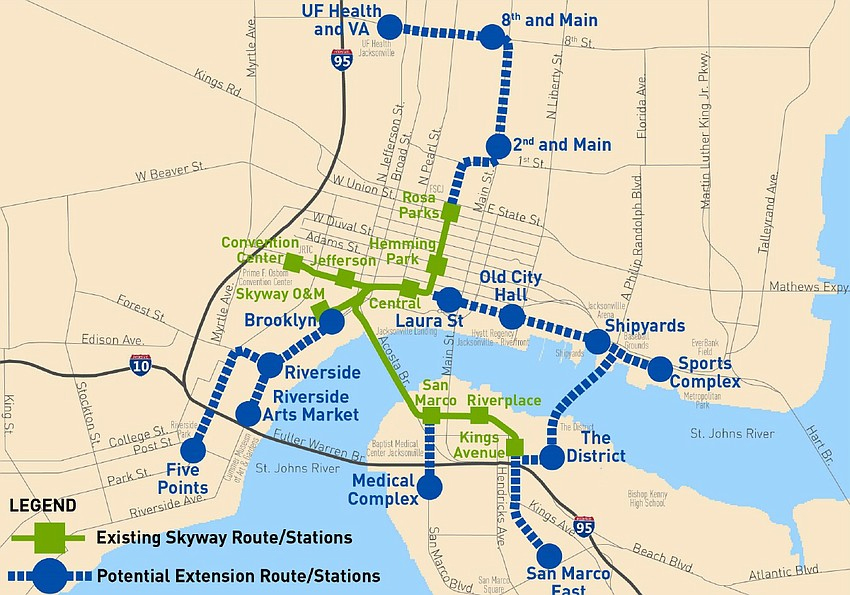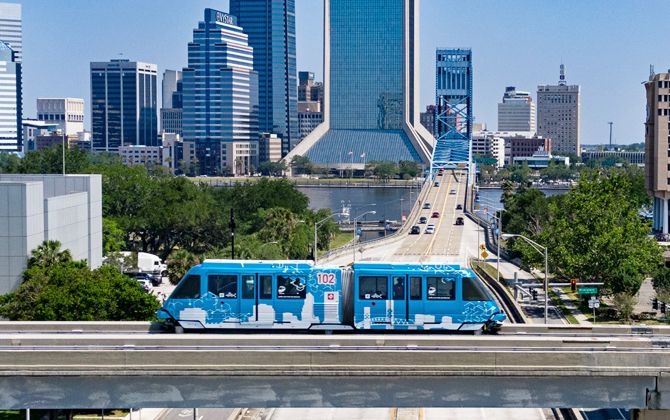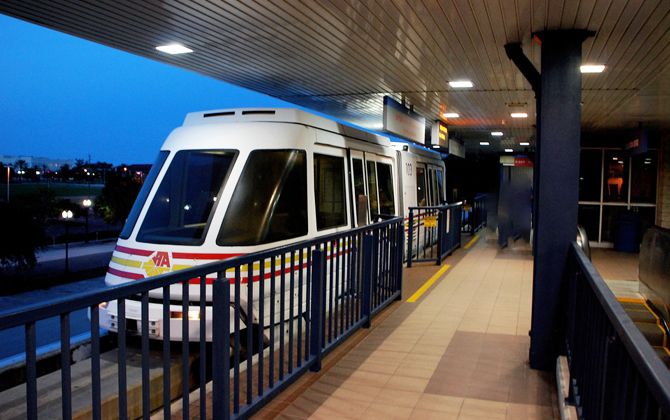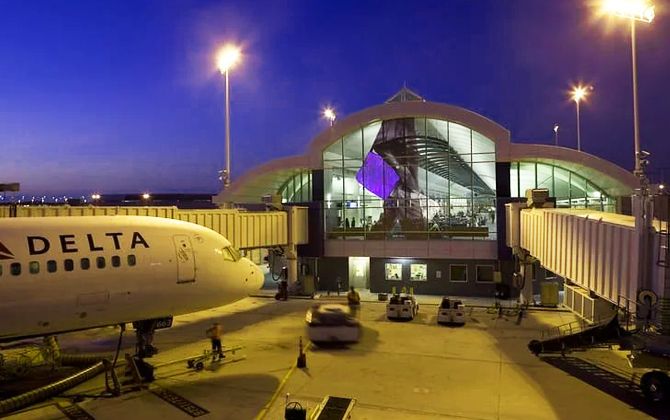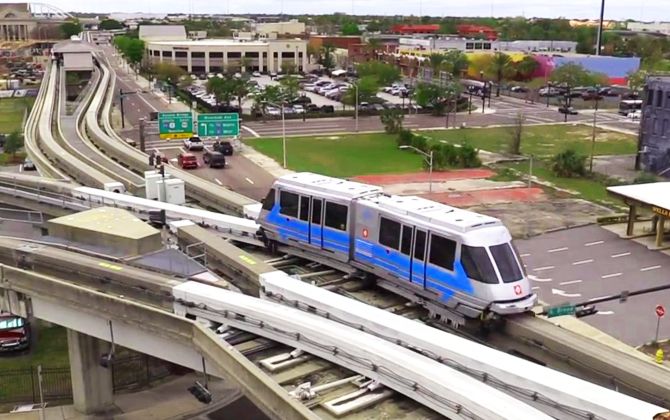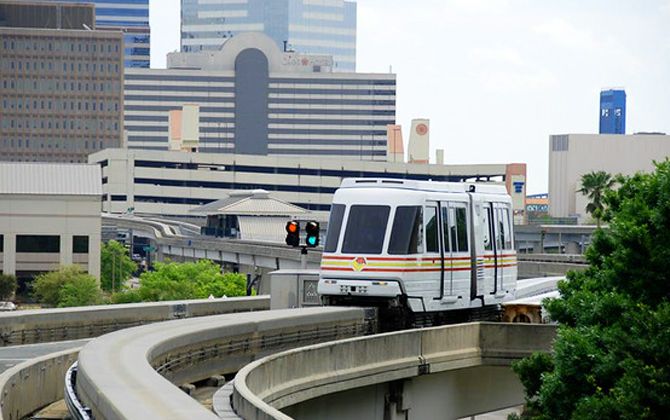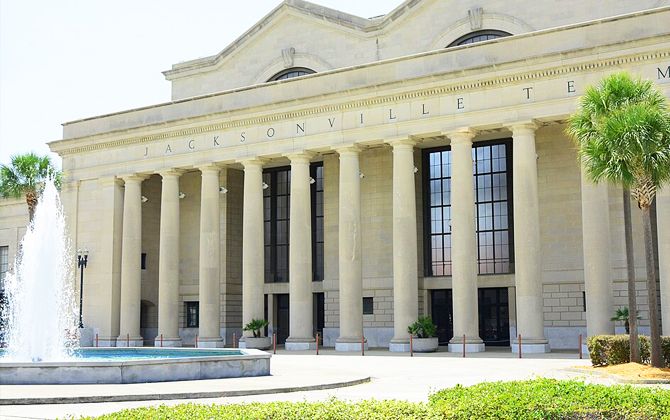The Jacksonville Skyway is an automated elevated people-mover in downtown Jacksonville, Florida. It runs along 2.5 miles (4 km) of track across the St. Johns River, with two routes — Northbank and Southbank — and eight stations.
The system opened in 1989 and is operated by the Jacksonville Transportation Authority (JTA).
Map of Jacksonville Skyway
As of 2026, the Skyway network is shown on official JTA maps as two loops in downtown Jacksonville. The Northbank Line extends west to LaVilla Station, while the Southbank Line runs south to Kings Avenue Station.
All trains stop at three transfer stations — Rosa Parks Transit Station, James Weldon Johnson Park Station, and Central Station — where the lines intersect. The JTA Skyway map (PDF) highlights all eight stations and key connections to buses and water taxis.
Map of Jacksonville Skyway showing different lines. Click on the map to enlarge it or download the Jacksonville Skyway map in PDF format.
Routes and Stations
The Skyway operates two routes branching from a central hub. The Northbank Line runs west from Rosa Parks Station to LaVilla Station. The Southbank Line runs south from Rosa Parks, crossing the St. Johns River to Kings Avenue Station. Below is an overview of each station:
LaVilla Station (Bay St & Lee St)
Western end of the Northbank Line. Formerly “Terminal/Convention Center Station,” it sits next to the Prime F. Osborn III Convention Center. The station serves the historic LaVilla district and connects to the Jacksonville Regional Transportation Center bus terminal.
Jefferson Station (Bay St & Jefferson St)
A central stop on the Northbank Line, located above Bay Street. It features a free Park-and-Ride lot and is close to downtown offices, just west of Central Station.
Central Station (Bay St & Julia St)
Main transfer point between the Northbank and Southbank lines. All trains stop here before splitting in either direction. Nearby are the Times-Union Center for the Performing Arts, the Northbank Riverwalk, and Water Taxi connections.
James Weldon Johnson Park Station (301 Hogan St)
Located at Hogan & Monroe, next to James Weldon Johnson Park (formerly Hemming Park). Key nearby landmarks include Jacksonville City Hall, the Main Library, MOCA Jacksonville, and the Federal Courthouse.
Rosa Parks Transit Station (Hogan St & Union St)
Northern terminus of the Skyway. Named after Rosa Parks, it is next to Florida State College at Jacksonville’s Downtown campus. Formerly the city’s main bus hub (until 2020), it now connects to JTA bus routes 10 and 19, plus the First Coast Flyer Red Line.
San Marco Station (701 San Marco Blvd)
First stop on the Southbank Line. Opened October 30, 1998, it stands on a three-story platform by the riverbank. Closest to the Museum of Science & History (MOSH) and Friendship Fountain, it is popular with visitors heading to parks and family attractions.
Riverplace Station (801 Flagler Ave)
Opened November 1, 2000, this Southbank stop sits at Flagler & Mary Streets. It serves the Southbank business district, the Southbank Riverwalk, and Treaty Oak Park, with Water Taxi access nearby.
Kings Avenue Station (1003 Kings Ave & Nira St)
Southern terminus of the Southbank Line. It has the largest Park-and-Ride facility in the Skyway system. Riders can reach Riverside-area hotels and restaurants from this station.
Fares and Tickets
The Jacksonville Skyway is completely fare-free. No tickets or passes are required — rides are always complimentary.
| Ticket Type | Price (USD) |
|---|---|
| Single ride (one-way) | $0 (free) |
All JTA passes and bus tickets are not valid on the Skyway, but they are also unnecessary.
Schedule & Operating Hours
The Skyway runs Monday through Friday, 6:00 AM – 9:00 PM. Trains arrive about every 4 minutes during peak hours (6–9 AM and 4–7 PM) and every 8 minutes during off-peak times.
On weekends, trains usually operate only for major downtown events or holidays, such as the Fourth of July and New Year’s Eve.
Policy for Extended Hours
For large civic events, JTA extends service beyond normal hours. Event organizers can also request additional service by submitting details in advance. Proposals should include the event date, duration, expected attendance, group size, and hotel capacity. If approved, JTA adds trains on weekends or late nights to accommodate demand.
Connection
The Skyway is part of Jacksonville’s larger transit system, offering several transfer options:
Bus Routes: Many JTA bus lines connect with Skyway stations. Central Station links to routes 1, 3, 11, 18 and express services 201 (Clay Express), 800 (Nassau Express), and XS2 (St. Johns Express). Rosa Parks Station connects to routes 10 and 19, as well as the First Coast Flyer Red Line. Other stations connect to nearby stops along Bay Street or San Marco Boulevard. At Kings Avenue Station, riders can board multiple Southbank bus routes.
Water Taxi: The Jacksonville Water Taxi runs along the St. Johns River, with docks near San Marco and Riverplace stations. These connections make it easy to reach riverfront attractions and downtown destinations.
Jacksonville Regional Transportation Center (JRTC): Located at 1000 W. Bay St. in the LaVilla area, the JRTC sits next to LaVilla Station. It serves as a major hub for JTA bus routes and also hosts Greyhound and Megabus services.
In practice, Skyway riders can transfer to city buses at Central and Rosa Parks stations, and to the Water Taxi at San Marco and Riverplace stations.
Connection to the Airport
Jacksonville International Airport (JAX) lies about 16 miles (26 km) north of downtown. The Skyway does not reach the airport, but JTA provides bus service. Route 1 (Airport) departs from the Jacksonville Regional Transportation Center at Bay J, next to LaVilla Station, and goes directly to JAX. The trip takes about 57 minutes, with buses running roughly once per hour. One-way fares cost about $1–3 USD (≈100–300 ₽).
Taxis and ride-shares are also available. By car, the trip to the airport usually takes 20–25 minutes without heavy traffic.
SkyWay Rules
All Skyway passengers must follow JTA’s Code of Conduct. Key rules include:
- No eating, drinking, or smoking on trains.
- Stay behind the yellow line until the train has fully stopped.
- Fold strollers and large items before boarding to keep aisles clear. Bicycles are allowed free of charge if space permits.
- Only ADA-defined service animals are permitted. Pets and other animals are not allowed.
- Remain seated or hold on while the train is moving. Weapons, hazardous materials, and disruptive behavior are strictly prohibited.
These and other rules are posted at stations and in JTA rider guides. Passengers should also respect station safety and courtesy, such as giving priority seating and keeping doors clear.
History
The Skyway was planned in the 1970s as a downtown people-mover. In July 1987, JTA awarded the first contract to French firm Matra. The initial segment opened on June 5, 1989, at a cost of $34.6 million (≈$91 million in 2026). It ran east–west with three stations: Central, Jefferson, and Terminal/Convention Center (now LaVilla).
In the mid-1990s, JTA switched to Bombardier technology. The system closed in late 1996 for upgrades, including new vehicles and controls. It reopened on December 15, 1997, with service extended north to Hemming Plaza (now James Weldon Johnson Park) and Rosa Parks Station.
Expansion across the river followed. San Marco Station opened on October 30, 1998, and Riverplace and Kings Avenue stations opened on November 1, 2000, completing the original network. The retired Matra cars were later sold to Chicago O’Hare Airport’s transit system.
For years the Skyway required a small fare, but in 2012 JTA made it completely free. Ridership grew by 61% that year. As of 2026, the Skyway remains fare-free.
Tips
- Use it for quick trips: Trains arrive every few minutes on weekdays, making the Skyway faster than walking across downtown’s wide streets and bridges.
- Bring a bike: Each train has free bike racks. Helmets and locks are recommended.
- Try the Water Taxi: From San Marco or Riverplace, take the ferry along the St. Johns River. It loops to Riverside Arts Market and back, offering a scenic ride.
- Connect to buses: Central and Rosa Parks stations link to many JTA routes. For example, from Central you can transfer to buses heading north on 1st Street or south on Atlantic Blvd.
Fun Facts About the Jacksonville Skyway
One of the first in the U.S.: The Skyway was among the earliest automated guideway systems in the country, similar to Miami’s Metromover. Its guideway beams are only 34 inches (86 cm) wide.
River crossing: The Skyway is the only automated rail line crossing the Acosta Bridge, giving riders sweeping views of the St. Johns River.
Driverless trains: The Bombardier Innovia monorail cars operate without drivers. They reach speeds of up to 35 mph (56 km/h) and usually run in two-car sets.
Always free: Riders save $1.75 USD (≈175 ₽), the cost of a standard JTA bus fare, on every trip.
Old trains to Chicago: The original Matra cars, retired in 1997, were sold to Chicago O’Hare Airport for its transit system.
Low ridership: Despite being free, the Skyway serves about 1,100 riders daily, or roughly 305,000 annually (2024). It was built for far higher numbers, which is why it often attracts media attention.
Park-and-Ride: Kings Avenue Station has one of downtown’s largest garages. Many commuters park there and ride into the city center.
Names with meaning: Rosa Parks Station honors the civil rights leader, while James Weldon Johnson Park Station is named for the poet and activist.
Future Expansions
JTA has been exploring ways to expand and modernize the Skyway. The main initiative is the Ultimate Urban Circulator (U²C) project, which will transform parts of the Skyway into an elevated autonomous-vehicle (AV) corridor. The first phase, the Bay Street Innovation Corridor, is scheduled to open in mid-2026, using the old track for shared automated shuttles. Grants have also been approved to design 7.5 miles (12 km) of new elevated guideways for AVs.
In addition, a new Skyway station is being built in the Brooklyn neighborhood, at the former maintenance yard. Construction began in late 2021, with the opening expected soon.
Critics of the System
The Skyway has faced criticism since its early years. Ridership has been much lower than expected, prompting some to call it a “$200 million ride to nowhere.” Observers point to a shrinking downtown workforce and the lack of service to key suburbs. Critics have dismissed it as a white elephant or even “a Jacksonville joke for a generation.”
Supporters counter that with future expansions and continued downtown development, the Skyway could still play a useful role.
Points of Interest Near the Monorail
The Skyway provides easy access to many downtown attractions. Highlights include:
- Prime F. Osborn III Convention Center (LaVilla Station): Jacksonville’s main convention center, located next to LaVilla Station.
- Library and Civic Center (JWJ Park Station): The Main Library and City Hall are steps from James Weldon Johnson Park Station.
- MOCA Jacksonville (JWJ Park Station): The Museum of Contemporary Art, one block from the station.
- Times-Union Center for the Performing Arts (Central Station): A major concert and theater venue, within walking distance of the station.
- Northbank Riverwalk (Central Station): A scenic riverside path with great downtown views.
- Friendship Fountain & MOSH (San Marco Station): The city’s iconic fountain and the Museum of Science & History sit by the station entrance.
- Jacksonville Landing/Riverfront Plaza (Central Station): The redeveloped riverfront plaza is right by Central Station.
- Florida State College Downtown Campus (Rosa Parks Station): Convenient for students at the northern end of the Skyway.
These destinations are all within walking distance — or a short Water Taxi ride — from Skyway stations, making the system a practical way to explore downtown Jacksonville.
